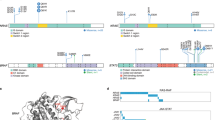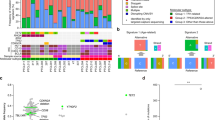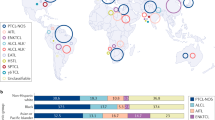Abstract
Peripheral T-cell lymphomas not otherwise specified (PTCL/NOS) are very aggressive tumors characterized by consistent aberrant expression of platelet-derived growth factor receptor alpha (PDGFRA). In this study, we aimed to identify the determinants of PDGFRA activity in PTCL/NOS and to elucidate the biological consequences of its activation. We observed overexpression of the PDGFRA gene by gene expression profiling in most of the tested PTCLs and confirmed the expression of PDGFRA and phospho-PDGFRA using immunohistochemistry. The integrity of the PDFGRA locus was demonstrated using several different approaches, including massive parallel sequencing and Sanger sequencing. PDGF-AA was found to be expressed and secreted by PTCL/NOS cells and to be necessary and sufficient for PDGFRA phosphorylation ex vivo by sustaining an autocrine stimulation. We documented consistently high PDGF-A expression in primary biopsies and patients’ plasma and tracked PDGFRA signaling in primary tumors, achieving evidence of its activation. Indeed, we found that STAT1 and STAT5 are implicated in PDGFRA signaling transduction. Finally, we demonstrated that PDGFRA activation supported tumor cell proliferation and provided the first evidence of the anti-lymphoma activity of PDGRA inhibition in a PTCL/NOS patient. Altogether, our data demonstrated that PDGFRA activity fosters PTCL/NOS proliferation via an autocrine loop.
This is a preview of subscription content, access via your institution
Access options
Subscribe to this journal
Receive 12 print issues and online access
$259.00 per year
only $21.58 per issue
Buy this article
- Purchase on Springer Link
- Instant access to full article PDF
Prices may be subject to local taxes which are calculated during checkout






Similar content being viewed by others
References
Jaffe ES, Harris NL, Stein H, Campo E, Pileri SA, Swerdlow SH . Introduction and overview of the classification of the lymphoid neoplasms. In: Swerdlow S, Campo E, Harris NL, Jaffe ES, Pileri SA, Stein H et al. (eds) WHO Classification of Tumors of Hematopoietic and Lymphoid Tissues, 4th edn Lyon: IARC, 2008; pp 158–166.
Dyer MJ, Siebert R . Peripheral T-cell non-Hodgkin's lymphoma NOS: naming of parts. Leukemia 2006; 20: 208–209.
Vose J, Armitage J, Weisenburger D . International peripheral T-cell and natural killer/T-cell lymphoma study: pathology findings and clinical outcomes. J Clin Oncol 2008; 26: 4124–4130.
Pileri SA, Weisenburger DD, Sng I, Jaffe ES, Ralfkiaer E, Nakamura S et al. Peripheral T-cell lymphoma, not otherwise specified. In: Swerdlow S, Campo E, Harris NL, Jaffe ES, Pileri SA, Stein H et al. (eds) WHO Classification of tumors of hematopoietic and lymphoid tissues, 4th edn Lyon: IARC, 2008; pp 306–308.
Pileri SA, Piccaluga PP . New molecular insights into peripheral T cell lymphomas. J Clin Invest 2012; 122: 3448–3455.
Piccaluga PP, Agostinelli C, Zinzani PL, Baccarani M, Dalla Favera R, Pileri SA . Expression of platelet-derived growth factor receptor alpha in peripheral T-cell lymphoma not otherwise specified. Lancet Oncol 2005; 6: 440.
Piccaluga PP, Agostinelli C, Califano A, Rossi M, Basso K, Zupo S et al. Gene expression analysis of peripheral T cell lymphoma, unspecified, reveals distinct profiles and new potential therapeutic targets. J Clin Invest 2007; 117: 823–834.
Iqbal J, Weisenburger DD, Greiner TC, Vose JM, McKeithan T, Kucuk C et al. Molecular signatures to improve diagnosis in peripheral T-cell lymphoma and prognostication in angioimmunoblastic T-cell lymphoma. Blood 2010; 115: 11.
Piccaluga PP, Agostinelli C, Califano A, Carbone A, Fantoni L, Ferrari S et al. Gene expression analysis of angioimmunoblastic lymphoma indicates derivation from T follicular helper cells and vascular endothelial growth factor deregulation. Cancer Res 2007; 67: 10703–10710.
Huang Q, Snyder DS, Chu P, Gaal KK, Chang KL, Weiss LM . PDGFRA rearrangement leading to hyper-eosinophilia, T-lymphoblastic lymphoma, myeloproliferative neoplasm and precursor B-cell acute lymphoblastic leukemia. Leukemia 2011; 25: 371–375.
Apperley JF, Gardembas M, Melo JV, Russell-Jones R, Bain BJ, Baxter EJ et al. Response to imatinib mesylate in patients with chronic myeloproliferative diseases with rearrangements of the platelet-derived growth factor receptor beta. N Engl J Med 2002; 347: 481–487.
De Keersmaecker K, Marynen P, Cools J . Genetic insights in the pathogenesis of T-cell acute lymphoblastic leukemia. Haematologica 2005; 90: 1116–1127.
Jones AV, Cross NC . Oncogenic derivatives of platelet-derived growth factor receptors. Cell Mol Life Sci 2004; 61: 2912–2923.
Board R, Jayson GC . Platelet-derived growth factor receptor (PDGFR): a target for anticancer therapeutics. Drug Resist Updat 2005; 8: 75–83.
Metzgeroth G, Schwaab J, Gosenca D, Fabarius A, Haferlach C, Hochhaus A et al. Long-term follow-up of treatment with imatinib in eosinophilia-associated myeloid/lymphoid neoplasms with PDGFR rearrangements in blast phase. Leukemia 2013; 27: 2254–2256.
Chen J, Petrus M, Bryant BR, Nguyen VP, Goldman CK, Bamford R et al. Autocrine/paracrine cytokine stimulation of leukemic cell proliferation in smoldering and chronic adult T-cell leukemia. Blood 2010; 116: 5948–5956.
Huang Y, de Reynies A, de Leval L, Ghazi B, Martin-Garcia N, Travert M et al. Gene expression profiling identifies emerging oncogenic pathways operating in extranodal NK/T-cell lymphoma, nasal-type. Blood 2009; 115: 1226–1237.
Laimer D, Dolznig H, Kollmann K, Vesely PW, Schlederer M, Merkel O et al. PDGFR blockade is a rational and effective therapy for NPM-ALK-driven lymphomas. Nat Med 2012; 18: 1699–1704.
Tagliafico E, Tenedini E, Manfredini R, Grande A, Ferrari F, Roncaglia E et al. Identification of a molecular signature predictive of sensitivity to differentiation induction in acute myeloid leukemia. Leukemia 2006; 20: 1751–1758.
Piccaluga PP, De Falco G, Kustagi M, Gazzola A, Agostinelli C, Tripodo C et al. Gene expression analysis uncovers similarity and differences among Burkitt lymphoma subtypes. Blood 2011; 117: 3596–3608.
Piccaluga P, Fuligni F, De Leo A, Bertuzzi C, Rossi M, Bacci F et al. Molecular profiling improves classification and prognostication of nodal peripheral T-cell lymphomas. Results of a phase 3 diagnostic accuracy study. J Clin Oncol 2013; 31: 3019–3025.
Eckerle S, Brune V, Doring C, Tiacci E, Bohle V, Sundstrom C et al. Gene expression profiling of isolated tumour cells from anaplastic large cell lymphomas: insights into its cellular origin, pathogenesis and relation to Hodgkin lymphoma. Leukemia 2009; 23: 2129–2138.
Went P, Agostinelli C, Gallamini A, Piccaluga PP, Ascani S, Sabattini E et al. Marker expression in peripheral T-cell lymphoma: a proposed clinical-pathologic prognostic score. J Clin Oncol 2006; 24: 2472–2479.
Ciccone M, Agostinelli C, Rigolin GM, Piccaluga PP, Cavazzini F, Righi S et al. Proliferation centers in chronic lymphocytic leukemia: correlation with cytogenetic and clinicobiological features in consecutive patients analyzed on tissue microarrays. Leukemia 2012; 26: 499–508.
Pileri SA, Ascani S, Cox MC, Campidelli C, Bacci F, Piccioli M et al. Myeloid sarcoma: clinico-pathologic, phenotypic and cytogenetic analysis of 92 adult patients. Leukemia 2007; 21: 340–350.
Piccaluga PP, Visani G, Pileri SA, Ascani S, Grafone T, Isidori A et al. Clinical efficacy and antiangiogenic activity of thalidomide in myelofibrosis with myeloid metaplasia. A pilot study. Leukemia 2002; 16: 1609–1614.
Vandenberghe P, Wlodarska I, Michaux L, Zachee P, Boogaerts M, Vanstraelen D et al. Clinical and molecular features of FIP1L1-PDFGRA (+) chronic eosinophilic leukemias. Leukemia 2004; 18: 734–742.
Walz C, Score J, Mix J, Cilloni D, Roche-Lestienne C, Yeh RF et al. The molecular anatomy of the FIP1L1-PDGFRA fusion gene. Leukemia 2009; 23: 271–278.
Mazzacurati L, Pattacini L, Brusa G, Mancini M, Benvenuti M, Barbieri E et al. Chk2 drives late G1/early S phase arrest of clonal myeloid progenitors expressing the p210 BCR-ABL tyrosine kinase in response to STI571. Hematol J. 2004; 5: 168–177.
Mancini M, Brusa G, Zuffa E, Corrado P, Martinelli G, Grafone T et al. Persistent Cdk2 inactivation drives growth arrest of BCR-ABL-expressing cells in response to dual inhibitor of SRC and ABL kinases SKI606. Leukemia Res 2007; 31: 979–987.
Chappell WH, Steelman LS, Long JM, Kempf RC, Abrams SL, Franklin RA et al. Ras/Raf/MEK/ERK and PI3K/PTEN/Akt/mTOR inhibitors: rationale and importance to inhibiting these pathways in human health. Oncotarget 2011; 2: 135–164.
Kohmura K, Miyakawa Y, Kawai Y, Ikeda Y, Kizaki M . Different roles of p38 MAPK and ERK in STI571-induced multi-lineage differentiation of K562 cells. J Cell Physiol 2004; 198: 370–376.
Hartmann S, Gesk S, Scholtysik R, Kreuz M, Bug S, Vater I et al. High resolution SNP array genomic profiling of peripheral T cell lymphomas, not otherwise specified, identifies a subgroup with chromosomal aberrations affecting the REL locus. Br J Haematol 2009; 148: 402–412.
William BM, Hohenstein M, Loberiza FR Jr, Caponetti GC, Bociek RG, Bierman P et al. Phase I/II study of dasatinib in relapsed or refractory non-hodgkin's lymphoma (NHL). ASH Annual Meeting Abstracts 2010; vol. 116, p. 288 http://abstracts.hematologylibrary.org/cgi/content/abstract/ashmtg;116/21/288 (accessed 19 November 2010).
Turner SD . Inimitable Imatinib: the range of targeted tumours expands to include T-cell lymphoma. Leukemia 2013; 27: 759.
Heldin CH . Autocrine PDGF stimulation in malignancies. Ups J Medi Sci 2012; 117: 83–91.
Graeber TG, Eisenberg D . Bioinformatic identification of potential autocrine signaling loops in cancers from gene expression profiles. Nat Genet 2001; 29: 295–300.
Agostinelli C, Piccaluga PP, Went P, Rossi M, Gazzola A, Righi S et al. Peripheral T cell lymphoma, not otherwise specified: the stuff of genes, dreams and therapies. J Clin Pathol 2008; 61: 1160–1167.
Gazzola A, Bertuzzi C, Agostinelli C, Righi S, Pileri SA, Piccaluga PP . Physiological PTEN expression in peripheral T-cell lymphoma not otherwise specified. Haematologica 2009; 94: 1036–1037.
Piva R, Agnelli L, Pellegrino E, Todoerti K, Grosso V, Tamagno I et al. Gene expression profiling uncovers molecular classifiers for the recognition of anaplastic large-cell lymphoma within peripheral T-cell neoplasms. J Clin Oncol 2010; 28: 1583–1590.
Tripodo C, Gri G, Piccaluga PP, Frossi B, Guarnotta C, Piconese S et al. Mast cells and Th17 cells contribute to the lymphoma-associated pro-inflammatory microenvironment of angioimmunoblastic T-cell lymphoma. Am J Pathol 2010; 177: 792–802.
Dave SS, Wright G, Tan B, Rosenwald A, Gascoyne RD, Chan WC et al. Prediction of survival in follicular lymphoma based on molecular features of tumor-infiltrating immune cells. N Engl J Med 2004; 351: 2159–2169.
Steidl C, Lee T, Shah SP, Farinha P, Han G, Nayar T et al. Tumor-associated macrophages and survival in classic Hodgkin's lymphoma. N Engl J Med 2010; 362: 875–885.
Basso K, Klein U, Niu H, Stolovitzky GA, Tu Y, Califano A et al. Tracking CD40 signaling during germinal center development. Blood 2004; 104: 4088–4096.
Heltemes-Harris LM, Farrar MA . The role of STAT5 in lymphocyte development and transformation. Curr Opin Immunol 2012; 24: 146–152.
Chiarle R, Simmons WJ, Cai H, Dhall G, Zamo A, Raz R et al. Stat3 is required for ALK-mediated lymphomagenesis and provides a possible therapeutic target. Nat Med 2005; 11: 623–629.
Heinrich MC, Corless CL, Duensing A, McGreevey L, Chen CJ, Joseph N et al. PDGFRA activating mutations in gastrointestinal stromal tumors. Science 2003; 299: 708–710.
Cuadros M, Dave SS, Jaffe ES, Honrado E, Milne R, Alves J et al. Identification of a proliferation signature related to survival in nodal peripheral T-cell lymphomas. J Clin Oncol 2007; 25: 3321–3329.
Acknowledgements
We are grateful to Dr Aurora Esposito for her technical assistance. This work was supported by the Centro Interdipartimentale per la Ricerca sul Cancro ‘G. Prodi’, BolognAIL, AIRC (IG4987; IG10519; 10007 5xMille; IG 2013N.14355), RFO (Prof Pileri and Prof Piccaluga), Fondazione Cassa di Risparmio in Bologna, Fondazione della Banca del Monte e Ravenna, Progetto Strategico di Ateneo 2006 (Prof Pileri and Prof Piccaluga), and FIRB Futura 2011 RBFR12D1CB (Prof Piccaluga).
Author information
Authors and Affiliations
Consortia
Corresponding author
Ethics declarations
Competing interests
The authors declare no conflict of interest.
Additional information
Supplementary Information accompanies this paper on the Leukemia website
Supplementary information
Appendix
Appendix
AIRC 5xMille consortium ‘Genetics-driven targeted management of lymphoid malignancies’: Robin Foà, Sabina Chiaretti, Filippo Berardelli, Brunangelo Falini, Enrico Tiacci, Giorgio Inghirami, Roberto Piva, Gianluca Gaidano, Davide Rossi, Stefano Pileri and Pier Paolo Piccaluga.
The European T-Cell Lymphoma Study Group: Italy: Giorgio Inghirami and Roberto Piva, (Azienda Ospedaliera Città della Salute e della Scienza di Torino, University of Torino); Marco Chilosi and Alberto Zamó (University of Verona); Fabio Facchetti and Silvia Lonardi (University of Brescia); Anna De Chiara and Franco Fulciniti (National Cancer Institute, Napoli); Claudio Doglioni, Andrés Ferreri and Maurilio Ponzoni (San Raffaele Institute, Milano); Claudio Agostinelli, Pier Paolo Piccaluga and Stefano Pileri (University of Bologna); Brunangelo Falini, Stefano Ascani, and Enrico Tiacci (University of Perugia); Belgium: Peter Van Loo, Thomas Tousseyn, and Christiane De Wolf-Peeters (University of Leuven); Germany: Eva Geissinger and Andreas Rosenwald, (University of Wuerzburg); Martin Leo Hansmann and Sylvia Hartmann (University of Frankfurt); Spain: Miguel Angel Piris and Maria E. Rodriguez (Hospital Universitario Marqués de Valdecilla, IFIMAV, Santander and Instituto de Investigaciones Biomédicas Alberto Sols, CSIC-UAM, Madrid).
Rights and permissions
About this article
Cite this article
Piccaluga, P., Rossi, M., Agostinelli, C. et al. Platelet-derived growth factor alpha mediates the proliferation of peripheral T-cell lymphoma cells via an autocrine regulatory pathway. Leukemia 28, 1687–1697 (2014). https://doi.org/10.1038/leu.2014.50
Received:
Revised:
Accepted:
Published:
Issue Date:
DOI: https://doi.org/10.1038/leu.2014.50



